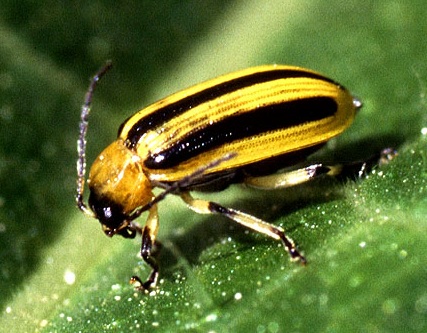
Features
Production
Research
Pests reduced, yields increased in organic research
March 16, 2009 By American Society for Horticultural Science
 March 12, 2009, Frankfort, KY – As the popularity of organic produce
March 12, 2009, Frankfort, KY – As the popularity of organic produce
increases with consumers, growers need more options to manage pests
naturally.
March 12, 2009, Frankfort, KY – As the popularity of organic produce increases with consumers, growers need more options to manage pests naturally.
 John D. Sedlacek and Gary R. Cline (retired) of the Land Grant Program at Kentucky State University led a research project designed to investigate options for reducing the presence of cucumber beetles.
John D. Sedlacek and Gary R. Cline (retired) of the Land Grant Program at Kentucky State University led a research project designed to investigate options for reducing the presence of cucumber beetles.
These pests damage crops by eating the roots, shoots, and flowers, and transmit the bacterial wilt pathogen. The study, published in the American Society of Horticultural Science journal HortTechnology, compares several practices in watermelon and muskmelon crops.
In 2002, watermelon was grown on black plastic mulch with the exception of one group, which was grown on Al-plastic, an aluminum coated plastic mulch previously linked to reduced cucumber beetle densities on squash. Another plot of watermelons was planted with companion plants thought to repel cucumber beetles. A third group was planted with a different set of companion plants that seem to attract insects that prey on cucumber beetles. Sticky traps stationed among the plants collected cucumber beetles, which were counted and removed on a weekly basis. The watermelon yields were not adversely affected by the Al-plastic nor by the companion plants.
More beetles were collected in the control and Al-plastic groups than the companion plant groups. Similar numbers of beetles were trapped in repellent plant groups and beneficial insect-attracting plant groups, suggesting these plants may be more valuable as a physical barrier to the beetles' movement than for their attractive or repellent properties.
In 2003, the study was replicated using muskmelons. Al-plastic was included again, but the companion plant groups were combined to include beetle-repelling radishes and predator-insect-attracting buckwheat. Other treatments included use of row covers and the organic insecticide PyGanic®. The separate Al-plastic and companion plant groups increased muskmelon yields of 75 per cent and 66 per cent, respectively, compared to the control. Row covers also significantly increased yield. The number of trapped beetles was significantly higher in the control group than in any other.
Then, in 2004, the study was repeated, but this time the insecticide group was replaced by a combination of Al-plastic and companion plants. Muskmelon weights varied significantly among all groups, with the greatest weights coming from the Al-plastic and companion plant combined groups with row covers. Weights in the Al-plastic-only group were greater than in the companion plant-only group.
All of the treatments, except for the insecticide, significantly increased yields compared to control groups. It appeared that some treatments, such as companion plants, might have reduced beetle populations by affecting adults, while others, such as the Al-plastic, may have affected beetle larvae still in the soil.
The complete study and abstract are available on the ASHS HortTechnology electronic journal web site at http://horttech.ashspublications.org/cgi/content/abstract/18/3/436.
Print this page